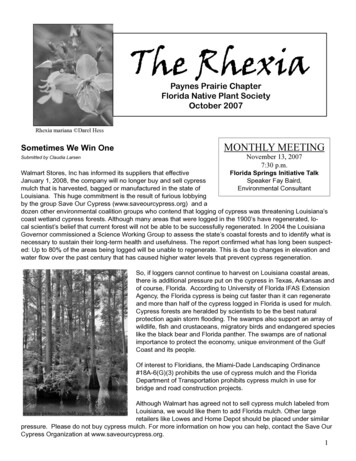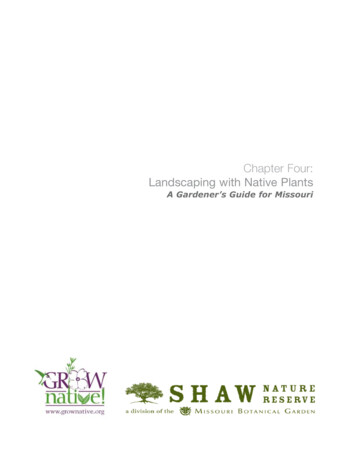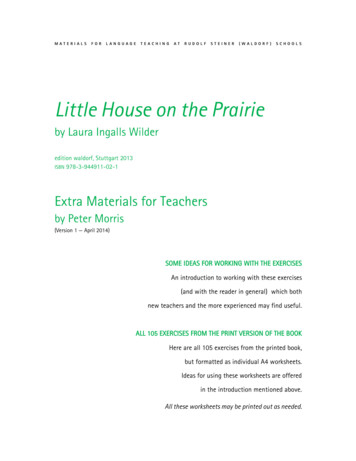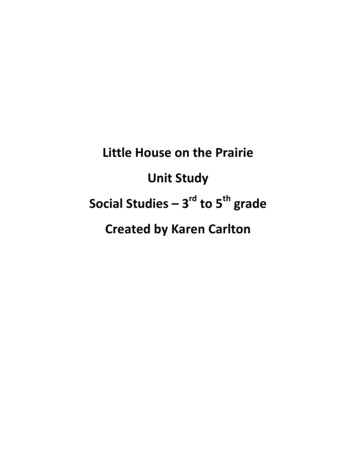
Transcription
The RhexiaPaynes Prairie ChapterFlorida Native Plant SocietyOctober 2007Rhexia mariana Darel HessSometimes We Win OneSubmitted by Claudia LarsenMONTHLY MEETINGNovember 13, 20077:30 p.m.Florida Springs Initiative TalkWalmart Stores, Inc has informed its suppliers that effectiveSpeaker Fay Baird,January 1, 2008, the company will no longer buy and sell cypressEnvironmental Consultantmulch that is harvested, bagged or manufactured in the state ofLouisiana. This huge commitment is the result of furious lobbyingby the group Save Our Cypress (www.saveourcypress.org) and adozen other environmental coalition groups who contend that logging of cypress was threatening Louisiana’scoast wetland cypress forests. Although many areas that were logged in the 1900’s have regenerated, local scientist’s belief that current forest will not be able to be successfully regenerated. In 2004 the LouisianaGovernor commissioned a Science Working Group to assess the state’s coastal forests and to identify what isnecessary to sustain their long-term health and usefulness. The report confirmed what has long been suspected: Up to 80% of the areas being logged will be unable to regenerate. This is due to changes in elevation andwater flow over the past century that has caused higher water levels that prevent cypress regeneration.So, if loggers cannot continue to harvest on Louisiana coastal areas,there is additional pressure put on the cypress in Texas, Arkansas andof course, Florida. According to University of Florida IFAS ExtensionAgency, the Florida cypress is being cut faster than it can regenerateand more than half of the cypress logged in Florida is used for mulch.Cypress forests are heralded by scientists to be the best naturalprotection again storm flooding. The swamps also support an array ofwildlife, fish and crustaceans, migratory birds and endangered specieslike the black bear and Florida panther. The swamps are of nationalimportance to protect the economy, unique environment of the GulfCoast and its people.Of interest to Floridians, the Miami-Dade Landscaping Ordinance#18A-6(G)(3) prohibits the use of cypress mulch and the FloridaDepartment of Transportation prohibits cypress mulch in use forbridge and road construction projects.Although Walmart has agreed not to sell cypress mulch labeled fromLouisiana, we would like them to add Florida mulch. Other largewww.tree-pictures.com/bald cypress tree pictures.htmlretailers like Lowes and Home Depot should be placed under similarpressure. Please do not buy cypress mulch. For more information on how you can help, contact the Save OurCypress Organization at www.saveourcypress.org.1
Another option for a November activity:Art and Native Plants - A class in BotanicalIllustration, With Susan Trammell, artist/scientificillustratorGreetings FNPS members! I hope that the summer wasa good one for you with lots of fun times and creativeendeavors. There have been some great mushroomspopping up in recentmonths. In hopes ofsome more rain, I’mplanning that the nextweekend workshop inbotanical illustrationwith watercolors willinclude mushroomsas well as plants. Oneadvantage of choosingto paint mushrooms isthat the pencil sketchstage goes easily andquickly since the formsare so simple. It’s all inthe shading and coloring. The dates for theworkshop are Saturday November 17th, from 10am-3pm (Lunch will beprovided); and Sunday 18th from 12-5pm (if a minimumof 3 people register). These workshops will include 10hours of instruction, all materials and lunch on Saturday.The first day you’ll take a brief walk in a six acre live oakwoods at my home near Archer, 10 miles from Gainesville. You’ll learn what aspects of a plant distinguish itfrom others, what details are important to illustrate andhow to choose a specimen. There will be some discussion about how to position the plant and compose adrawing or photograph to show those features and youcan pick a plant to paint from cut or potted specimens.The focus will be on how to show not only the intrinsicbeauty of a plant, but the details that make eachspecies unique. The remainder of the day will be spentrendering a plant with pencil, transferring that imageto watercolor paper and possibly applying some color.The second day will be mainly devoted to dry brushwatercolor technique. Though you may not finish yourpainting that day, you’ll learn tips on how to finish it laterin your home or studio.All materials and Saturday’s lunch are included in the 100 fee. The workshop will be limited to 6 people formore one-on-one feedback. For more information call352-495-8723, and to view Susan’s beautiful art work,visit her website:www.SusanTrammell.com2Speaking of art and native plants, check out theseresources to find the coloring sheets we used forbutterfly festival as well as others. These booksare fun and great learning tools for both theyoung and old!Florida Wildflowers Coloring Book at: k.pdfFlorida Wildflower Coloring Book oridaWildflower Coloring Book.pdfNative Plant Coloring Book at: www.fnps.org/pages/fnps/page announcement.php?id 772Florida Scrub Coloring Book at: olorindex.htmIndian River Lagoon Coloring Book at: www.sfwmd.gov/stude/cb.htmWetland and Invasive Plantsof the Southeast Coloring Book at:plants.ifas.ufl.edu/colbook.htmlMarine Alphabet Coloring Book at: research.myfwc.com/products/product info.asp?id 4077Central Florida Birds Coloring Book at: .pdfFlorida Insect Coloring Book at: 1.pdfEndangered Species Coloring Book at: www.epa.gov/espp/coloring/ or www.fws.gov/southwest/es/mexicanwolf/pdf/ES coloring book.pdf
Plants from the October chapter meeting plant ID workshop** Denotes invasive exotic plantsAesculus paviaAmpelopsis arboreaCinnamomum camphora**Commelina communisConoclinium coelestinumDrymaria cordataHamelia patensHelianthus simulansHyptis mutabilisKoelreuteria elegans**Lantana camara**Melia azedarach**Oplismenus hirtellusPanicum sp, or Dicanthelium sp.Passiflora suberosaPhyla nodifloraPhysalis arenicolaPhysalis cordataPinus taedaPolygonella robustaPrunus umbellata ?Psychotria nervosaSalvia coccineaSolidago fistulosaSolidago tortifoliaSubmitted by Paul CohenRed buckeyePeppervineCamphorweedAsiatic dayflowerBlue mistflowerDrymaryFirebushMuck sunflowerTropical bushmintGolden Rain tree, FlamegoldLantana, ShrubverbenaChinaberry treeBasketgrass, WoodgrassPanicgrassCorkystem passionflowerCapeweed, Turkey Tangle FrogfruitCypresshead groundcherryHeatleaf groundcherryLoblolly pineLargeflower Jointweed orSandhill WireweedFlatwoods plum, Hog PlumWild CoffeeTropical Sage, Blood SagePinebarren goldenrodTwistedleaf veNativeNativeNativeNativeNativeSome Observations . . .According to the “Guide to the Vascular Plants of Florida” by R. P.Wunderlin and B. F. Hansen, the Chinaberry Tree, Melia azedarach,blooms in the spring and the Golden Rain Tree, Koelreuteria elegans,flowers in the fall. As of this writing the yellow flowers of the Golden Raintree are tuning into orange red fruits. In the spring the Chinaberry treeswill have inconspicuous white flowers which will become yellow berries.The mature bark of the Golden Rain tree is smoother than the Chinaberrytree’s shaggy bark. However the leaves of the two trees are almostindistinguishable even though the two plants come from different families.According to Rufino Osorio in “A Gardeners Guide to Florida NativePlants,” Passiflora suberosa serves as larval food for the fritillarybutterflies, julias, and zebra longwings. The purple black berries areattractive to various birds. Osorio recommends using P.suberosa for small gardens and potted specimens.A bare branch mysteriously turned up at the workshop table. I have no idea where it came from. It looked like eitherPrunus umbellata or P. angustifolia. Barry Davis of the Herbarium at the Florida Museum of Natural History (FMNH) hasseen P. umbellata in bloom this fall, but they were unable to ascribe an identification to the species level based on thespecimen of the bare branch in bloom that was provided. Kent Perkins, manager of the collection, said that leaves wouldbe needed to determine the species level. He further indicated that if the plant was cultivated there might be other possibilities.Thank-you all participants, particularly Carol Lippincott. I extend special thanks to the Herbarium at the (FMNH) for verification of some of the plants brought . The plant ID workshop is educational and not a plant ID service. Nomenclature isbased on “Atlas of Florida Vascular Plants” (http://www.plantatlas.usf.edu).3
Calendar of EventsPlease check Paynes Prairie chapter page at www.FNPS.orgfor most current information and directions to field trips.All meeting are at the Doyle Conner Auditorium, 7:30 pmPlant ID workshop prior to meeting at 6:30November 13, Chapter MeetingFlorida Springs Initiative TalkSpeaker Fay Baird, Environmental Consultant“Land Conservation and Springs Protection:Recent Achievements, Big Challenges”Fay Baird is currently the coordinator for the two Florida Springs Working Groups at Silver Springs and the Lower Santa Fe Riversprings in Alachua and Gilchrist counties. She is a hydrologist with a long-standing interest in land-use planning. In addition toprivate environmental consulting, Fay is a former Town Commissions and Planning Board member in Micanopy, Florida. For moreabout Fay Baird, check out: http://silverspringsbasin.blogspot.com/ Please join us to learn about the present and future plansfor Florida water in our area. In addition to our speaker, we will take a few moments to vote on the slate of Paynes Prairie chapterofficers and board-of-directors for 2008. The program will be followed by refreshments and a plant raffle.November 17, Field Trip OnePontoon Trip on Silver River Sorry, this trip is full!We hardly had time to publicize the November Pontoon trip before it was filled up! Those of you who signed up at the Septembermeeting will be traveling six miles on the Silver River with Captain Vince Druding or Awareness Adventures, Inc. Silver Springs is worldrenown as the largest documented artesian outflow and for its long history as a tourist attraction with glass bottomed boats. What is notpublicized is the beautiful journey the spring water takes along the pristine Silver River to the Ocklawaha River through dense swampsand floodplain forests of cypress, ash, gum and red maple. More than a dozen small springs occur below the head springs, and abundant vegetation and fish are easily seen in the crystalline water. A diversity of wildlife utilizes the lowland habitat, including wading birds,alligators, turtles, river otters and the most unusual local denizens, the Rhesus monkeys, originally released by an early concessionairein the 1930’s. Captain Vince has been leading river trips for more than 15 years and is a graduate of the Florida Master NaturalistProgram. This trip along 6 miles of the Silver River to the head springs is a favorite of the local Audubon Society Chapter and SilverRiver State Park volunteers.The Silver River boat trip will meet Captain Vince at Ray Wayside Park at SR 40 east of silver springs but just before the OcklawahaRiver at 9:00 a.m. Nov 17, 2007. Participants should plan on 1hour 15 minute drive to meet Captain Vince at boat landing. Eachpassenger should bring their 15 fee as cash or a check. The trip will take approximately 3 hours. If there are questions, or in case ofcancellation due to inclement weather, you should contact Captain Vince at Awareness Adventures, 352-690-7140, orhttp://www.marioncountyfl.org/PR612/PR ParkDirectory.htm. Again, this trip is now full.November 17, Field Trip TwoRiver Rise State ParkTrip leader: Anne Barkdoll, Florida Park ServiceFor those of you who still wish to participate in a November field trip, we are going to explore the restoration area at River Rise StatePark near High Springs. This park area was recently in the news as a group of equestrian riders challenged the Park’s plans to restorean upland red oak community. We will carpool to the site and then take 2 state trucks to drivefurther into the park. We will look at a couple restoration sites of different ages and discuss the importance of uplandhabitat.Time: 8:30-2:00pm. Difficulty: ModerateMeet: At Publix at 8:30 am to carpool to siteBring: Hat, water, sunscreen, light snack. IMPORTANT: Wear appropriate clothing for protection against ticks!For trip cancellation information call: Claudia Larsen @ 352-466-3880November 20, FNPS Chapter Board Meeting4
December 11, Holiday Get-Together SocialCome Party with your Native Plant Friends! The PaynesPrairie Chapter does not have a December speaker, but weplan on getting together tocelebrate Christmas, Winter, Solstice, Football, Food,Friendship, Plants, CoolWeather (your pick). Join usat the Doyle Conner Buildingthis informal meeting to get toknow each other better andenjoy spontaneous conversahttp://plantatlas.usf.edution! There will be no formalprogram but we will havea small silent auction for some new, old and curious items. Ifyou have something horticulturally related that you would like todonate, call Claudia at 352-846-1070 (email at calarsen@ufl.edu).Your contribution of dessert or light snacks will be appreciated forthis FNPSget-together.January 8, 2008Chapter MeetingDr. Buzzy Guillette, Florida Museum of Natural HistoryJanuary 12January 26, 2008Field Trip TBAGreat Air Potato RoundupFebruary March, April, and May 2008 schedules forchapter meetings and field trips are to be announced.FNPS Fall Plant Sale ReportThe Fall Native Plant Sale at Morningside Nature Centerwas another huge success. It seems the sketchy weatheron Friday night may have scared off some shoppers but thatwas a big mistake. The weather cleared and it cooled downbeautifully just before the sale started. Those who did comeout were treated to wonderful conditions and first choice onthe lovely variety of plants. At least one vendor sold out onFriday night! Saturday brought more delightful weather asthe public filtered into Morningside. Our chapter’s boothwas kept busy dispensing information and advice, givingpersonal shopping tours to homeowners, and signing upnew members. We made 437 at our booth during the plantsale. We sold 135 raffle tickets, and the rest came fromt-shirts, books, and landscape guides. We signed up 4 newmembers on Saturday and another 27 on Friday night! Wereceived at the last minute a very generous donation ofmuhly grass from Riverview Flowers Farms (Riverview, FL),which the Friends of Nature Parks sold for 5 each. Proceeds from that sale will go directly to the FoNP’s children’sscholarship fund. All of the donated muhlys sold exceptone, which we’ll bring for the November meeting’s raffle.A big thank you to all our volunteers at the chapter booth,without whom our sale would not be possible: Jamie (Mr.Scones) Barichivich, Howard (Officer) Jelks, Lisa Modola,Charlie (Raffle tickets!) Pedersen, Brian (Load ‘em up)Quinn, Goldie (Card Please) Schwartz, Erick Smith, andJennifer (Endurance) Staiger. The Spring Native Plant Saleis slated for April 11-12, 2008. Submitted by Lisa JelksOctober FNPS Program ReportSubmitted by Claudia LarsenThe basket was passed around and we timidly ate leavesof Beggarticks/Bidens alba to see what a wild plant wouldpresent to our palette. Our speaker, Susan Marynowski,has 20 years of edible and herbal plant experience andher enthusiasm about eating wild plants was verified withinformation on vitamins and minerals that can be easilyabsorbed by making leaf teas, tonics or just eating freshleaves. As long as plants are in areas where they are notsprayed with pesticides or contaminated by auto exhaust,many are safe to eat raw in salads or prepared like spinach. Many non-native exotic weeds can be eaten also.Some of Susan’s favorite edibles included fresh mulberries,elderberry flowers and fruit, all plants in the hibiscus family,and violet flowers and leaves. Fresh greens for you saladscan include leaves from plants like chickweed, false dandelion, beggarticks, oxalis, smilax and purslane. Thanksagain Susan foryour great talkand we lookforward to ourfield trip with youin March 2008 tofind edible plantsin the wild andlearn more aboutthem!http://plantatlas.usf.eduFYI: Further Readings and Resources on WildEdiblesThe Forager’s Harvest: A Guide to Identifying,Harvesting, and Preparing Edible Wild Plantsby Samuel ThayerField Guide to Edible Wild Plantsby Bradford AngierA Field Guide to Edible Wild Plants:Eastern and Central North Americaby Lee Allen Peterson (Author),Roger Tory Peterson (Illustrator)Edible Wild Plants:A North American Field Guideby Thomas S. Elias, Peter A. Dykeman (Contributor)The Encyclopedia of Edible Plants of North Americaby Francois, Ph.D. Couplan, James A. DukeThe Illustrated Guide to Edible Wild Plantsby Department of the Army (Author)Identifying and Harvesting Edible and Medicinal Plantsby Steve BrillStalking the Wild Asparagusby Euell Gibbons5
An Announcement from Friends of PaynesPrairie State ParkPublic input is being sought on plans to restore waterquality in local lakes and creeks. Learn how a coalition ofpublic and private organizations and community groupsare working to restore water quality in Hogtown Creek,Sweetwater Branch, Tumblin Creek, Lake Wauberg,Newnans Lake, Orange Lake and Alachua Sink/PaynesPrairie. One of these bodies of water probably affectsyour neighborhood so please consider attending thismeeting. You can view educational exhibits at 6pm andhear an overall presentation at 6:30pm. Small groupdiscussions will follow the meeting.Date: November 7Place: Alachua Co Health Dept Auditorium, 224SE 24 St., GainesvilleFNPS Membership UpdatesThe lines of demarcation for Paynes Prairie Chapterhave been gradually changing over the last year withthe creation of the Ixia Chapter in Jacksonville, theCitrus Chapter, and most recently the new chapter inOcala/Marion County. Our chapter now consists ofAlachua, Baker, Bradford, Columbia, Dixie, Gilchrist,Hamilton, Lafayette, NE Levy, Putnam, Suwanneeand Union counties and is composed of 415 members.Remember we are all still one big family, so you canvisit other chapters to hear their speakers, attendfield trips and enjoy special activities like plant sales.Most of the chapters list a calendar of events locatedat the www.FNPS.org website.List of nominees for the FNPSPaynes Prairie Chapter Offices.Open nominations and voting willtake place at the November Chaptermeeting on 11/13/2007PresidentVice Pres.SecretaryTreasurerChap. Rep.Director 1Director 2Director 3Director 1Director 16Brian Quinn?Erick SmithJoe DurandoHeather BlakeBern HolthuisDebbie DeloachJill McGuireClaudia LarsenEllen ThomsPAYNES PRAIRIE CHAPTER OFTHE FLORIDA NATIVE PLANT SOCIETYThe Rhexia is published monthly September - November andJanuary - May by the Paynes Prairie Chapter of theFlorida Native Plant Society.The purpose of the FloridaNative Plant Society is thepreservation, conservation,and restoration of the nativeplants nd native plant communities of Florida. See ourwebsite at www.fnps.org.OFFICERS - DIRECTORSPresidentCharlie e PresidentBrian Quinn/b.quinn@.usda.ars.govSecretaryClaudia Larsen/Calarsen@.ufl.edu / 352.846.1070TreasurerJoe Durando/386.462.5455Chapter RepresentaiveErick Smith/Edsmith@ufl.edu / 352.380.0648MembershipGoldie Schwartz/afn49@mindspring.com / 352.495.3983Field Trip CoordinatorSandra Vardaman/sandravardaman@aol.comNewsletter EditorMary Santello/santellom@gmail.com/ 352.378-3098Newsletter DistributionAlice Tyler/pinetyl@atlantic.net / 352.528.3968Plant RescueJ. Barichivich/jamie barichivich@usgs.gov / 352.375.1972Publicity & MediaVacant positionDirectorDebbie DeLoach/debbiedeloach@cox.netDirectorMary Rhodes/dockone@hotmail.co,/ 352.475.2344DirectorJennifer Staiger/jennifer staiger@usgs.govDirectorSandra Vardaman/sandravardaman@aol.comDirectorVacant PositionDirectorVacant PositionARTICLE SUBMISSIONPlease send all articles to: Rhexia@gmail.com.Due to the holidays, there will be noDecember edition of the Rhexia. The deadlinedate is December 15 to submit articles for theJanuary 2008 newsletter.
Advertisements are now being accepted for the Rhexia newsletter!If you would like to support the Paynes Prairie chapter please send a business card size adto Charlie Pedersen at charliepedersen@gmail.com. The ads cost 100 and runs from October 2007 to September 2008.NOTESTEIN NATIVE NURSERYString LilyCrinum americanumTree AgaveAgave decipiensStiff DogwoodCornus foeminaRed MullberryMorus rubraFlatwoods PlumPrunus umbulata100 species trees, shrubs, ground cvr.Gainesville / Appointment: 372-2107Shop Online and Raise Funds for FNPSThe next time you need to shop online, check out Giveline.com and a portion of your purchase will be donated to FNPS!Giveline.com has over a million best-selling products, and every purchase you make generates a donation for FNPS.Giveline.com is an online store created for the community-minded shopper, offering more than a million products including books, movies, music, electronics, house wares, gifts and more. Every purchase generates a donation to FNPS - anaverage of 16% of sales will go directly to FNPS. FREE shipping for a limited time for new shoppers (Use discount codeNCD07 during checkout). submitted by Karina Veaudry7
Florida Native Plant SocietyPaynes Prairie ChapterPost Office Box 110670Gainesville, FL 32611Next meetingTuesday, November 13th7:30 p.m.(Plant ID Workshop at 6:30)Doyle Conner Bldg. DPI1911 SW 34th St.Gainesville, FLMonthly MeetingsRegular monthly meetings are held the 2nd Tuesdayin September - November and January - May at 7:30 p.m. at the:Doyle Conner BuildingDivision of Plant Industry1911 SW 34 St., GainesvillePlant ID workshops precede each meeting at 6:30 p.m.
retailers like Lowes and Home Depot should be placed under similar pressure. Please do not buy cypress mulch. For more information on how you can help, contact the Save Our Cypress Organization at www.saveourcypress.org. MONTHLY MEETING November 13, 2007 7:30 p.m. Florida Springs Init










